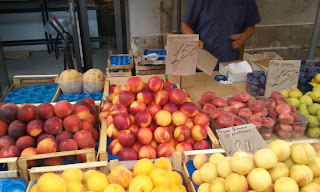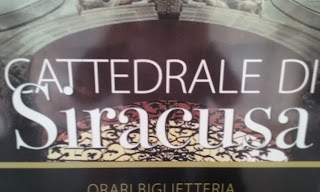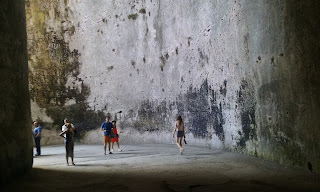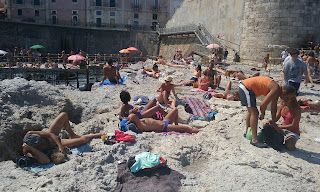






A few of Caroline Shepard's shots from around Siracusa!

 shots from our favorite beach outside of siracusa!
shots from our favorite beach outside of siracusa!It was raining when we set out to explore Siracusa. This 2700 year old city has countless layers, as a mythical place, a site for countless invasions, and a modern city. We walked out quietly, making our way to the fish market to find some fresh food we could cook ourselves. Walking over, we made our way through the island of Ortegia, the island where we are staying, passing through the windy medieval streets of this once Greek City, past the Tempio de Apollo on the way to the market. We passed a watering hole, with kids were swimming, people out, men cutting oysters, selling sandwiches and other wares. We wanted eat everything, the peaches, the fish, the spices. After pulling together our picnic goods and dinner for two nights, we set out for Calamosche Siracusa, a beach off a national park outside the city that felt like Joshua Tree National Park, where between dry land and cactuses, we found blue waters to swim all afternoon. The place was full of Italians enjoying the day, vamping around in their skimpy almost nothing bikinis and bathing suits.
Later that night, we enjoyed our first home cooked meal in five weeks, enjoying some tuna and swordfish and a green broccoli like vegetable I’ve never seen before. It was still delicious. The Etna wine was lovely. The view from our room of Piazza San Giuseppe ever better.
The next day, we’d venture out of the old city past the Siracusa Cathedral. As Vinceno Salerno puts it:
“Histories of early Christianity and the fall of the Roman Empire usually mention the conversion ofGreek and Roman temples into churches. On paper, at least, it seems fairly simple: As the people converted, so did their places of worship.
This spawned the "romanesque basilica" style of ecclesiastical architecture which, truth be told, was as much Greek as it was Roman. Yet the early Romanesque was little more than an imitation of the very first temples-cum-churches. While a number of these churches can be seen in the Mediterranean world, particularly in Greece and Italy, the most imposing of all is SiracusaCathedral, which began its life as the magnificent, golden limestone Temple of Athena during the fifth century BC (BCE), dominating the acropolis on the highest point of the island of Ortygia.”
Gradually, we made our way past the ships out of the old city to the Neapolis Archaeological Park holding most Siracusa’s archeological ruins. In the hot sun, we took in the stone queries, the Greek Theater and the Roman Amphitheater. The query, dubbed the Latomia del Paraidiso, is full of orange and lemon trees. Below is a narrow cavern some 70 feet high, 200 deep, 25 feet wide dubbed, Dionysus’ Ear by the artist Caravaggio- either because of its shape or astounding acoustics. Sound echoes from side to side. Walking inside the hole, it become pitch black. I dropped my glasses, needing to kneel to find them. Some Italians wondered if I was praying, but then I showed them my missing glasses case. And they helped me find them. As the website for the national park puts it:
Dionysius' name enters the picture from a local legend that this ancient tyrant used this cave as a prison and its acoustics to spy on his captives. Not that Dionysius was a tyrant or anything. "Tyrant" was actually the official name of the ruler of Syracuse in that era—like saying "king" or "president" or "governor." That isn't to say he wasn't above playing hardball politics; just that he wasn't tyrannical in the modern meaning of the word. (Oh, and aside from similar-sounding names, he had nothing to do with the Roman god of wine, either—that "Dionysus.")
Looking around this epic place, one feels the history of this storied place. Homer is said to have written much of Odyssey based on his inspiration from the Western Mediterranean, that is Sicily. And I can feel this in these storied spaces.
I could feel it later as we swam in a watering hole along the old city wall, among blue water water, gay men cruising and women cavorting, Italians taking in the sun. Women were drinking beer, guys sitting looking out, looking for someone. I swam out into the distance, darting in and out of the waves.
We’ve walked 300 miles since we got to Italy. To get through the trip, we’ve read some Shakespeare, taking on Hamlet to think about life and fate. I thought of these tragedies as we looked at the Greek Theater, where gradually more and more of the performances involved gladiator performances.
Caroline talks about Virgil and Ovid, who was said to have fallen out of favor with Augustus because his writings were so sensual and vivid, espousing libertine ways. We’ll read more Ovid when we get home.
After swimming, Caroline lead us out for a snack of buratta in a small cafe. I drank some wine. The kids had some dolce. And we all made our way home.
We really have to live here some time, she suggests, looking about this city with the perfect watering holes, Greek ruins, and walking paths. It was a lovely two day making our way through this majestic city of history.













































































































































































































































































No comments:
Post a Comment